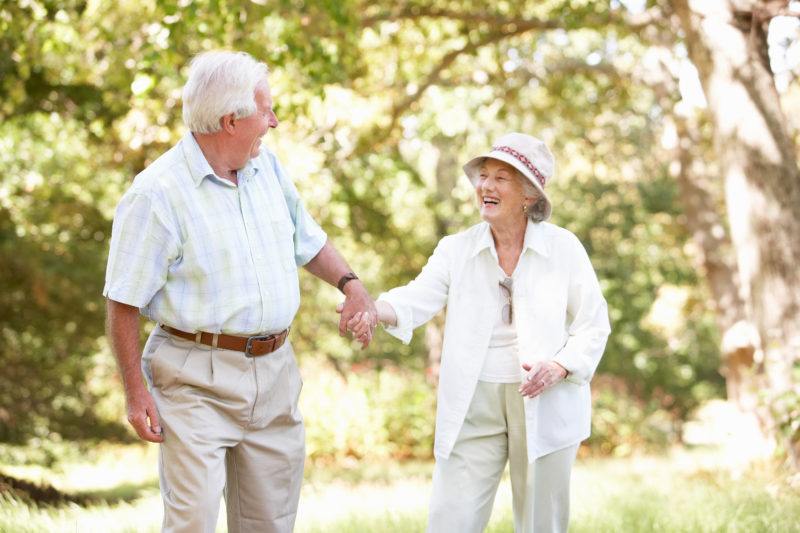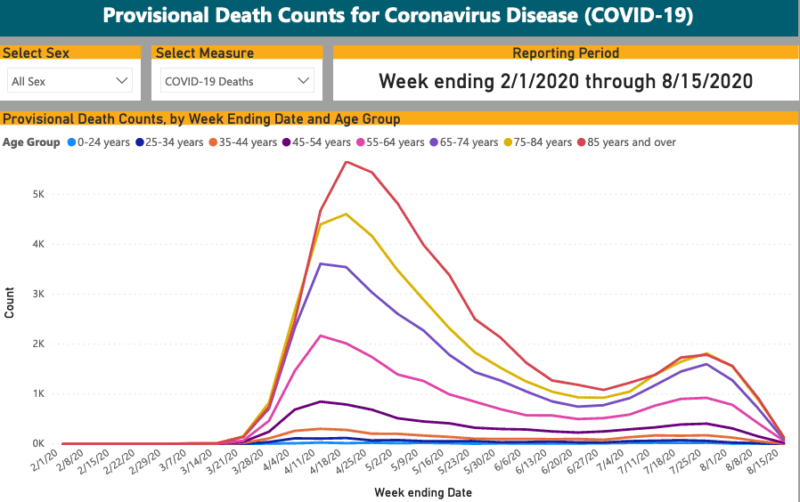Older Americans Should Be Anti-Lockdown Activists

It’s happened to quite a number of us. We write against the lockdowns for all the incredible economic, psychological, and institutional carnage they have caused, and how they have shattered our expectations of our rights and freedoms, and our presumptions about what government has the power to do to us.
We can make a convincing case; we see no basis for disrupting social functioning in the event of a pandemic, no matter how terrible it is, as I’ve been writing since January 27, 2020. Indeed that original article assumed as a matter of argument that C-19 was going to be as bad as Ebola, which it very obviously is not.
As the pandemic unfolded, it became clear that there is an undeniable demographic to the C-19 virus threat, something we’ve known since perhaps February if not earlier. I believed at the time that the realization would cause policy to get smarter (I wrote this on April 5). Rather than wreck society, we clearly needed a demographic-based response that could be voluntary rather than coercive. The fatality threat level for healthy people under 65 is lower than the risk of dying in a car crash.

As demographic data has poured in, and it has finally become common knowledge that the average age of death with/from COVID-19 is 80 years with comorbidities. Indeed, in only 6% of COVID deaths is COVID listed as the only cause; the typical death from COVID-19 lists 2.6 additional health factors.
Once this became obvious, so too has come the accusation that those who oppose lockdowns care nothing for the lives of the aged and infirmed. We are trying to kill grandmother, as the popular lockdowner saying goes. It’s a purely emotional argument that basically accuses anti-lockdowners of bad faith, which is a particularly nasty way to go about disagreeing with anyone.
It’s especially offensive given the many lives lost in New York and New Jersey long-term care facilities due to governments having forced COVID-19 patients on them. Cuomo in particular forced 6,300 patients into these facilities, exposing the most vulnerable in the middle of a pandemic, and resulting in many thousands and perhaps tens of thousands of unnecessary deaths.
Still, the claim keeps being made that those who favor openness are being cruel toward older Americans. The opposite is true. The whole point of how a free society deals with a pandemic is to share the burden of gaining immunity among the population that is least vulnerable in order that the virus can burn itself out through herd immunity, exactly as we have always done. Once this process plays out, older and vulnerable populations can live their lives in safety from the virus, the sooner the better.
This is why schools should never have closed, why beaches should have stayed open, and why bars, dance clubs, and professional meetings should have gone ahead. Calm and normal social functioning were necessary to deal a swift blow to the virus so that the vulnerable populations would not be forced to shelter in place for many months, much less a full year.
The refreshingly blunt Knut Wittkowski made this point at the outset of the pandemic.
With all respiratory diseases, the only thing that stops the disease is herd immunity. About 80% of the people need to have had contact with the virus, and the majority of them won’t even have recognized that they were infected, or they had very, very mild symptoms, especially if they are children. So, it’s very important to keep the schools open and kids mingling to spread the virus to get herd immunity as fast as possible, and then the elderly people, who should be separated, and the nursing homes should be closed during that time, can come back and meet their children and grandchildren after about 4 weeks when the virus has been exterminated….
His 80% figure, of course, turns out to be far less due to shared immunities with other Coronaviruses and inherent T-cell immunity. The latest estimates of the herd immunity threshold is 10-20%, meaning that this virus can be dispatched quickly upon arrival provided we do not impose measures to keep people apart by force. Even the New York Times has covered this.
Cancelling schools and events only prolongs the pain and increases the risk that the vulnerable populations are exposed through errors in judgment, or otherwise die of loneliness and sadness due to restrictions on visitors and being cooped up indoors for months and months. This is extremely cruel.
Sunetra Gupta of Oxford University goes further to say that the policies of forced closures and imposed distancing are deeply immoral and a violation of the social contract. To add a new virus to the coded immunities of the human experience absolutely requires widespread exposure among those who are not vulnerable (80% of cases under the age of 25 are asymptomatic).
“Herd immunity is a way of preventing vulnerable people from dying,” she says plainly, “let people go about their business, allow herd immunity to build up.”
This is a remarkable insight that might seem counterintuitive to us today. But this is because we’ve apparently lost knowledge of how the immune system works.
In mid April, David Katz, one of the nation’s leading virulogists from Yale and author of 17 books, went on Bill Maher’s show and explained in the clearest terms he could: “I think people have a hard time… confronting and accepting: we actually kind of want to get this, and get it over with, and be immune because that is the path to the all-clear that doesn’t require us to make or wait for a vaccine.”
Still, his plea went unheard. These health experts have found themselves very frustrated by their failure to get it through to policy makers that “slowing the spread” and “flattening the curve” only prolongs the pain and forces vulnerable populations to stay isolated in ways that are harmful to mental and physical health.
Speaking out to help everyone understand this has been Harvard Medical School Professor Martin Kulldorff, who, fed up with all the nonsense being preached by the lockdowners, wrote a series of articles and sent tweets to clarify the realities of viruses:
We should appreciate young adults who help generate herd immunity by living normal lives and keeping society afloat. When people throw misguided complaints at you, falsely claiming that you are endangering others, remember that the opposite is true.
Immunity is age dependent. If we protect the low-risk young, through e.g. school closures, but not the high-risk elderly, sending infected individuals to nursing homes, then there will be many deaths. Very sad.
Most infectious disease epidemiologists I talk to favor an age-tailored mitigation strategy to minimize mortality. Among vocal scientists in other fields, most seem to advocate a suppression strategy through general age-wide counter-measures and lockdowns. Why? I do not know.
Tel Aviv University Immunology Professor Udi Qimron explains:
For the same reason, I would open up the whole education system, because the vast majority is made up of people who are not at risk. Of course a solution needs to be found for teachers suffering from diabetes or other background diseases, but I see no reason to prevent activities that encourage the economy. Not only because it allows parents to go to work, but also because it lowers mortality in the long run. I would also ask children and young people to take off their masks. Of course, it is impossible to force a child to take off a mask, but proper information will do the job.
At the same time, I would call on at-risk populations, our parents and people with background illnesses, to avoid social gatherings in the coming months until we reach the appropriate immunity depth. It is possible and desirable to recommend at-risk populations to wear masks. I would also open the skies and abolish the isolation obligation for those returning from abroad. With the situation of carriers abroad compared to within Israel, there is no reason to isolate tourists, just as you and I are not isolated even though we have an even higher probability than that of a random tourist from abroad to be a carrier. These are things that got into our minds four months ago and we do not understand that their time has passed.
All of this wisdom is the opposite of the strange global policy priority of “run and hide” from a virus. It makes no scientific sense, and it is contrary to every intuition that a free society should have. Herd immunity is not a strategy; it is like gravity, a recognition of reality, as Kullsdorff says.
I get that this is a difficult subject in an age that demands easy answers to everything, so let me personalize this a bit. Back in March, when many people had become concerned about the virus, I wanted to see my mother across the country. She is absolutely among the vulnerable populations due to age and health. I refrained from visiting her for fear that I could be a carrier. She objected but still I refrained. She then said, it’s ok, “this virus will be gone in a month or two once young people get it and get over it.”
Of course she had no idea that the world would go full medieval, that schools would be shut down, that people were forced apart, that events would be cancelled, and that the whole of society would pursue a policy of prolonging the pain as long as possible. We don’t know to what extent all these lockdowns actually prevented herd immunity from arriving sooner but it is possible that this is precisely what happened. That means that she must go a longer period of time to wait in relative isolation to see her family including me.
It would not be entirely wrongheaded to describe lockdown and social distancing regulations as equally selfish on the part of young people as it is cruel to older people, whereas an age-specific policy of herd immunity is the compassionate and rational route.
The people who are trying to educate others about all this describe their alternative view as a “policy,” but it is not necessarily that. All one needs to do in order to achieve the best results is to preserve social functioning in absence of panic, which is what we’ve done in the United States over the last hundred years. Older and infirm populations have long known to avoid crowds during flu season. As for the non-vulnerable populations, they’ve always just gone about their lives such as holding Woodstock in the middle of a pandemic.
The best policy on dealing with a virus – bolstering immunities among young people while protecting the vulnerable – is the freedom to behave rationally. Any other policy risks the kind of carnage we see all around us today, even as the virus has wickedly and profoundly affected our oldest Americans. Lockdowns have done nothing to protect anyone while creating astonishing chaos and confusion all around, with no evidence that they have minimized mortality for any groups.










